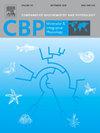当暴露于两栖动物宿主的纬度变化的上限时,肠道微生物群基本上不变。
IF 2.1
3区 生物学
Q4 BIOCHEMISTRY & MOLECULAR BIOLOGY
Comparative Biochemistry and Physiology A-Molecular & Integrative Physiology
Pub Date : 2025-01-22
DOI:10.1016/j.cbpa.2025.111816
引用次数: 0
摘要
气候变化将增加极端温度出现的频率和严重程度。宿主热生理学与其肠道微生物群之间的联系表明,生物对未来气候的反应可能是由其微生物群介导的,这就提出了热环境如何影响微生物群本身的问题。脊椎动物肠道微生物群通过对免疫、新陈代谢和营养吸收的影响来影响宿主的生理可塑性。尤其是外温脊椎动物的肠道微生物群对环境温度长期、亚致死性的逐渐升高有反应。对于肠道微生物群是否以及如何对短暂暴露于宿主生理耐受上限(CTmax)的温度做出反应,目前还知之甚少,但这可能会对宿主的健康状况产生下游影响。我们测定了林蛙(Lithobates sylvaticus)在 10° 纬度梯度上 15 个种群的 CTmax。然后,我们对暴露于CTmax后两个时间点的幼蛙肠道微生物群进行了表征。纬度较高的蛙类比纬度较低的蛙类具有更低的热耐受性(更低的CTmax)。出乎意料的是,暴露于较高的可存活温度对蛙类微生物群的丰富度、稳定性或组成几乎没有影响。相反,我们发现了时间的强烈影响,在恢复条件下饲养四天的蛙类与只恢复了一天的蛙类相比,肠道微生物群的多样性较低,但稳定性较高,与暴露于 CTmax 的情况无关。我们的结论是,虽然高纬度地区的林蛙比低纬度地区的林蛙耐热性更差,但它们的微生物群落基本上不受短暂暴露于其生理极限边缘高温的影响。本文章由计算机程序翻译,如有差异,请以英文原文为准。

Gut microbiomes are largely unchanged when exposed to their amphibian host's latitudinally variable upper thermal limit
Climate change will increase the frequency and severity of temperature extremes. Links between host thermal physiology and their gut microbiota suggest that organisms' responses to future climates may be mediated by their microbiomes, raising the question of how the thermal environment influences the microbiome itself. Vertebrate gut microbiomes influence the physiological plasticity of their hosts via effects on immunity, metabolism, and nutrient uptake. The gut microbiota of ectothermic vertebrates in particular are responsive to long-term, sub-lethal gradual increases in environmental temperature. Whether and how the gut microbiota respond to brief exposure to temperatures at the upper limit of host physiological tolerance (CTmax) is poorly understood but could have downstream effects on host fitness. We assayed the CTmax of wood frogs (Lithobates sylvaticus) from 15 populations across a 10° latitudinal gradient. We then characterized the gut microbiota of juveniles at two time points following exposure to CTmax. Frogs from higher latitudes had lower thermal tolerance (lower CTmax) than those from lower latitudes. Unexpectedly, exposure to upper survivable temperature had little to no detectable effect on the frogs' microbiota richness, stability, or composition. Instead, we found a strong effect of time in which frogs kept in recovery conditions for four days had less diverse, but more stable gut microbiota than those that had recovered for only one day, regardless of CTmax exposure. We conclude that while wood frogs from higher latitudes have reduced thermal tolerances than those from lower latitudes, their microbial communities are largely unaffected by brief exposure to high temperatures at the edge of their physiological limits.
求助全文
通过发布文献求助,成功后即可免费获取论文全文。
去求助
来源期刊
CiteScore
5.00
自引率
4.30%
发文量
155
审稿时长
3 months
期刊介绍:
Part A: Molecular & Integrative Physiology of Comparative Biochemistry and Physiology. This journal covers molecular, cellular, integrative, and ecological physiology. Topics include bioenergetics, circulation, development, excretion, ion regulation, endocrinology, neurobiology, nutrition, respiration, and thermal biology. Study on regulatory mechanisms at any level of organization such as signal transduction and cellular interaction and control of behavior are also published.

 求助内容:
求助内容: 应助结果提醒方式:
应助结果提醒方式:


